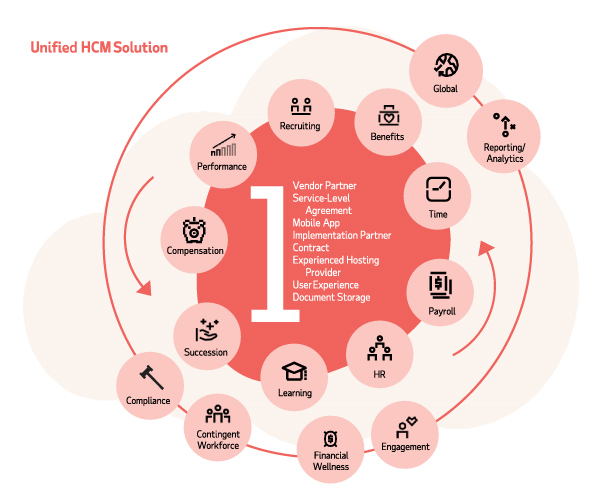As technology and tactics have evolved, human capital management evaluation has become more complex. But the opportunity to deliver workforce optimization to your organization is still within reach. It’s time to consider how to transform a cumbersome task into a strategic, goal-oriented process.
Choosing HCM vendors
When selecting an HCM vendor, you have the option of working with one or many. You can purchase solutions from different providers for each application area, which is known as a best-of-breed approach. Or, you can opt for a unified solution that brings together all HCM services under one vendor. Whichever route you choose, it’s just one step in the process of human capital management evaluation and in many ways, it’s the easy part. The difficulty is often the internal battle to gain organizational support and buy-in for the selected solution.

Five keys to human capital management evaluation
ADP, in collaboration with Gartner1, has identified five key internal business considerations to help you navigate the HCM buying process:
Step 1 – Determine organizational impact
Having a clearly defined outcome for your project will help guide the decision-making process, ensure a successful implementation and ultimately may result in a satisfied organization. First, determine your business goals and the HCM challenges that may prevent you from achieving them. Then, project the impact those missed opportunities will have on your organization.
Step 2 – Construct a plan
Once an overall outcome has been established, having a clear plan of action is critical for project success. Plan considerations may include:
- Project scope
- Organizational and cultural impact
- Current systems and vendors that may be improved, modified or removed
- Budget, including total cost of ownership and return on investment
- Project team and leadership assignments
- Other projects that may compete for the same resources
- Internal and external security requirements
Step 3 – Confirm internal stakeholders
In addition to the project team and the directly impacted staff, identify which business unit leaders may also be affected by a new HCM system. Internal stakeholders from all of your geographic regions should be represented to ensure engagement.
Step 4 – Establish common and negotiable ground
Once the plan is constructed, a team assigned and stakeholders identified, it’s imperative to establish the priorities and objectives. This may mean familiarizing yourself with your organization’s approval process, determining budget availability and identifying any vetting processes required for working with an external HCM vendor.
Step 5 – Secure stakeholder commitment
To secure formal approval for an HCM vendor, present the solution to your organization’s key decision-makers and influencers. This presentation should include:
- Product demonstrations
- Business, financial and end-user benefits
- Implementation processes and timelines
- HCM vendor’s customer references
- Impact mitigation strategies
- Policies and procedures that would need modification
Download the 5 Key Considerations When Evaluating HR & Payroll Vendors or see our guide to buying an HCM System.
1Gartner (Formerly CEB), Driving Customer Consensus, Arlington VA, 2014.
Go deeper
- Article HCM Buyer's Guide
- PDF HCM Requirements Checklist




